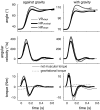Do we use a priori knowledge of gravity when making elbow rotations?
- PMID: 22205232
- PMCID: PMC3282902
- DOI: 10.1007/s00221-011-2981-8
Do we use a priori knowledge of gravity when making elbow rotations?
Abstract
In this study, we aim to investigate whether motor commands, emanating from movement planning, are customized to movement orientation relative to gravity from the first trial on. Participants made fast point-to-point elbow flexions and extensions in the transverse plane. We compared movements that had been practiced in reclined orientation either against or with gravity with the same movement relative to the body axis made in the upright orientation (neutral compared to gravity). For each movement type, five rotations from reclined to upright orientation were made. For each rotation, we analyzed the first trial in upright orientation and the directly preceding trial in reclined orientation. Additionally, we analyzed the last five trials of a 30-trial block in upright position and compared these trials with the first trials in upright orientation. Although participants moved fast, gravitational torques were substantial. The change in body orientation affected movement planning: we found a decrease in peak angular velocity and a decrease in amplitude for the first trials made in the upright orientation, regardless of whether the previous movements in reclined orientation were made against or with gravity. We found that these decreases disappeared after participants familiarized themselves with moving in upright position in a 30-trial block. These results indicate that participants used a general strategy, corresponding to the strategy observed in situations with unreliable or limited information on external conditions. From this, we conclude that during movement planning, a priori knowledge of gravity was not used to specifically customize motor commands for the neutral gravity condition.
Figures







Similar articles
-
Energy-related optimal control accounts for gravitational load: comparing shoulder, elbow, and wrist rotations.J Neurophysiol. 2014 Jan;111(1):4-16. doi: 10.1152/jn.01029.2012. Epub 2013 Oct 16. J Neurophysiol. 2014. PMID: 24133223
-
Gravity-specific adaptation of the angular vestibuloocular reflex: dependence on head orientation with regard to gravity.J Neurophysiol. 2003 Jan;89(1):571-86. doi: 10.1152/jn.00287.2002. J Neurophysiol. 2003. PMID: 12522203
-
Disentangling gravitational, environmental, and egocentric reference frames in spatial neglect.J Cogn Neurosci. 1998 Nov;10(6):680-90. doi: 10.1162/089892998563095. J Cogn Neurosci. 1998. PMID: 9831737
-
Gravity estimation and verticality perception.Handb Clin Neurol. 2018;159:43-59. doi: 10.1016/B978-0-444-63916-5.00003-3. Handb Clin Neurol. 2018. PMID: 30482332 Free PMC article. Review.
-
The sensorimotor and cognitive integration of gravity.Brain Res Brain Res Rev. 1998 Nov;28(1-2):92-101. doi: 10.1016/s0165-0173(98)00030-7. Brain Res Brain Res Rev. 1998. PMID: 9795160 Review.
Cited by
-
Why are the digits' paths curved vertically in human grasping movements?Exp Brain Res. 2013 Jan;224(1):59-68. doi: 10.1007/s00221-012-3288-0. Epub 2012 Oct 6. Exp Brain Res. 2013. PMID: 23283419
-
An upper-limb power-assist exoskeleton using proportional myoelectric control.Sensors (Basel). 2014 Apr 10;14(4):6677-94. doi: 10.3390/s140406677. Sensors (Basel). 2014. PMID: 24727501 Free PMC article.
-
Gravity support from a robotic exoskeleton increases spontaneous use of the nondominant upper extremity during a choice reaching task.J Neurophysiol. 2024 Dec 1;132(6):1693-1703. doi: 10.1152/jn.00261.2024. Epub 2024 Oct 30. J Neurophysiol. 2024. PMID: 39475492
-
Body orientation contributes to modelling the effects of gravity for target interception in humans.J Physiol. 2019 Apr;597(7):2021-2043. doi: 10.1113/JP277469. Epub 2019 Feb 6. J Physiol. 2019. PMID: 30644996 Free PMC article.
-
Initial information prior to movement onset influences kinematics of upward arm pointing movements.J Neurophysiol. 2016 Oct 1;116(4):1673-1683. doi: 10.1152/jn.00616.2015. Epub 2016 Jul 13. J Neurophysiol. 2016. PMID: 27486106 Free PMC article.
References
MeSH terms
LinkOut - more resources
Full Text Sources

